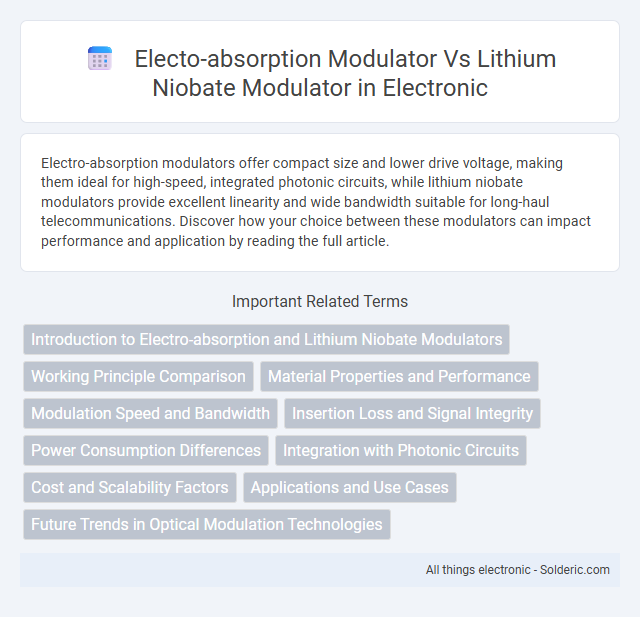Electro-absorption modulators offer compact size and lower drive voltage, making them ideal for high-speed, integrated photonic circuits, while lithium niobate modulators provide excellent linearity and wide bandwidth suitable for long-haul telecommunications. Discover how your choice between these modulators can impact performance and application by reading the full article.
Comparison Table
| Feature | Electro-Absorption Modulator (EAM) | Lithium Niobate Modulator (LiNbO3) |
|---|---|---|
| Modulation Principle | Changes in absorption via electric field | Electro-optic effect (Pockels effect) changes refractive index |
| Wavelength Range | Typically 1300-1550 nm | Broad range, 1260-1650 nm and beyond |
| Modulation Speed | Up to 40 GHz | Up to 70 GHz |
| Insertion Loss | Moderate (2-5 dB) | Low (<3 dB) |
| Drive Voltage | Low (~1-3 V) | High (3-10 V) |
| Size | Compact and integrated | Larger, bulkier device |
| Fabrication Complexity | Complex semiconductor processing | Mature, well-established fabrication |
| Applications | High-speed telecom, short-distance links | Long-haul communications, analog and digital modulation |
Introduction to Electro-absorption and Lithium Niobate Modulators
Electro-absorption modulators (EAMs) leverage the quantum-confined Stark effect to modulate light intensity by varying the electric field across a semiconductor waveguide, enabling high-speed data transmission in compact photonic devices. Lithium niobate modulators utilize the Pockels effect within a lithium niobate crystal to achieve phase modulation with low optical loss and a wide bandwidth, making them ideal for long-haul optical communication systems. The fundamental distinction lies in EAM's direct absorption modulation suitable for integration with semiconductor lasers versus lithium niobate's refractive index modulation offering superior linearity and stability.
Working Principle Comparison
Electro-absorption modulators operate by varying the absorption coefficient of a semiconductor material under an applied electric field, enabling direct modulation of light intensity through quantum-confined Stark effect. Lithium niobate modulators utilize the Pockels effect, where an electric field induces a change in refractive index within the crystal, modulating the phase of light that can be converted to intensity modulation using interferometric structures. While electro-absorption modulators achieve high-speed modulation with compact device footprints due to intrinsic material properties, lithium niobate modulators offer low insertion loss and broad bandwidth, benefiting from mature waveguide technology and stable electro-optic response.
Material Properties and Performance
Electro-absorption modulators utilize semiconductor materials like indium phosphide or quantum well structures, enabling high-speed modulation with compact device size and low driving voltage. Lithium niobate modulators employ a crystalline material known for its excellent electro-optic coefficients, offering wide bandwidth and low insertion loss but typically requiring higher voltage and larger footprint. Your choice depends on the trade-off between integration density and modulation speed versus driving voltage and device size, where electro-absorption excels in miniaturization and lithium niobate provides superior performance for demanding telecom applications.
Modulation Speed and Bandwidth
Electro-absorption modulators (EAMs) offer high modulation speeds typically exceeding 40 GHz and exhibit bandwidths suitable for high-speed optical communication systems. Lithium niobate modulators provide lower modulation speeds, generally up to 40 GHz, but benefit from wide optical bandwidths and excellent linearity, making them ideal for analog and digital signal applications. The choice depends on the trade-off between the higher speed and integration capability of EAMs versus the broader operational bandwidth and robustness of lithium niobate modulators.
Insertion Loss and Signal Integrity
Electro-absorption modulators exhibit lower insertion loss compared to lithium niobate modulators, enhancing overall signal strength in high-speed optical communication systems. Lithium niobate modulators maintain superior signal integrity with lower chirp and better linearity, resulting in reduced signal distortion over long distances. The trade-off between insertion loss and signal integrity is critical in selecting the appropriate modulator for specific applications such as data centers and telecommunications networks.
Power Consumption Differences
Electro-absorption modulators typically consume less power than lithium niobate modulators due to their inherent semiconductor-based design, enabling lower driving voltage and compact integration. Lithium niobate modulators demand higher power for maintaining strong electro-optic effects over longer interaction lengths, resulting in increased overall energy usage. This power efficiency difference makes electro-absorption modulators preferable in portable or power-sensitive optical communication applications.
Integration with Photonic Circuits
Electro-absorption modulators (EAMs) offer seamless integration with photonic circuits due to their compact size and compatibility with semiconductor fabrication processes, enabling efficient on-chip modulation. Lithium niobate modulators traditionally require bulkier components and separate assembly, posing challenges for dense photonic circuit integration. Your choice of modulator hinges on whether compact integration or high performance in discrete setups is the priority.
Cost and Scalability Factors
Electro-absorption modulators are generally more cost-effective and easier to integrate into large-scale photonic circuits compared to lithium niobate modulators, which require complex fabrication processes and higher material costs. The scalability of electro-absorption modulators benefits from their compact size and compatibility with semiconductor manufacturing techniques, making them suitable for mass production. Your choice depends on balancing initial investment against performance needs, with electro-absorption modulators offering improved affordability and scalability for high-volume applications.
Applications and Use Cases
Electro-absorption modulators (EAMs) are widely used in high-speed optical communication systems, particularly in data centers and metro networks, due to their compact size and low drive voltage requirements. Lithium niobate modulators excel in long-haul telecommunications and advanced photonic integrated circuits because of their high linearity, broad bandwidth, and excellent thermal stability. Both modulators are critical in 5G networks, coherent optical transmission, and quantum communication, with EAMs favored for cost-sensitive short-reach links and lithium niobate for performance-critical long-distance applications.
Future Trends in Optical Modulation Technologies
Electro-absorption modulators demonstrate significant potential for future optical communication systems due to their compact size, low voltage operation, and high-speed modulation capabilities, making them ideal for integration in photonic circuits. Lithium niobate modulators, known for their excellent electro-optic coefficients and wide bandwidth, continue to evolve with advancements in thin-film lithium niobate technology, enabling improved performance and miniaturization. Emerging trends emphasize hybrid integration and silicon photonics compatibility, aiming to enhance modulation efficiency, reduce power consumption, and scale production for next-generation high-capacity optical networks.
Electo-absorption modulator vs Lithium niobate modulator Infographic

 solderic.com
solderic.com